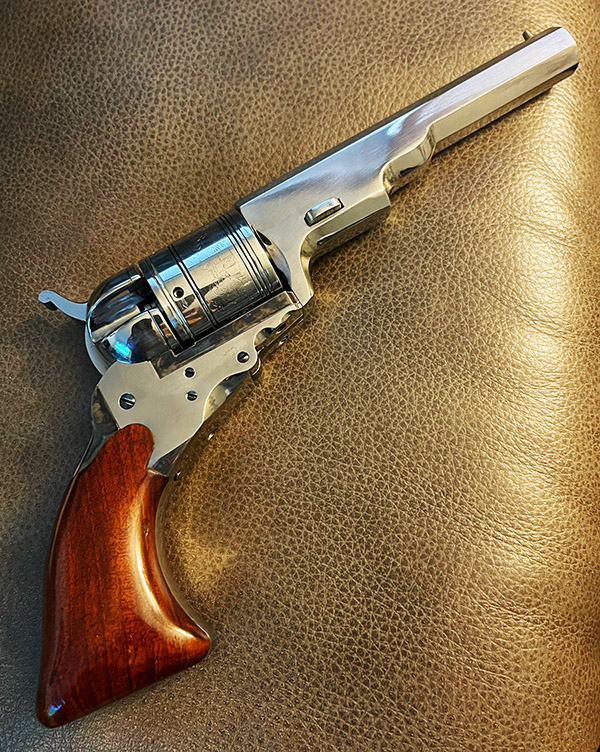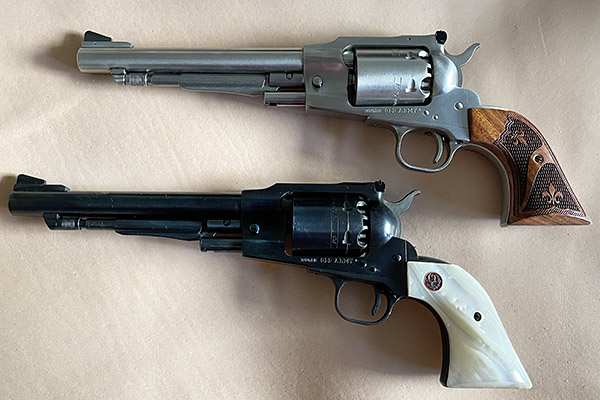By Joe Berk
Here’s another fascinating custom revolver that showed up in our Uberti Facebook page. It’s from good buddy Steve, who sent additional photos and is allowing us to use the story here on ExNotes. Here’s what Steve shared with me:
I have an original Paterson in its original configuration of .36 caliber (I mean an original Uberti Paterson, of course). I searched for years for a way to buy a conversion cylinder for it. I stumbled across this and could not pass it up.

A little history on this one…the way it was converted was the gunsmith milled down a Harrington and Richardson .22 barrel and sleeved it into the Paterson barrel. Then he used standard .22 Magnum sleeves in the cylinder The loading ramp was milled such that it pins the base of the round in, so there was no need for a loading gate.

The barrel and frame are actually the original blue steel. The gunsmith dip stripped the parts then meticulously polished them to a bright shine. I just keep it well oiled.
Steve, your .22 Magnum Paterson is a great looking gun. Thanks for allowing us to share it here. For our ExNotes readers, the Paterson was the original Colt revolver patented by Samuel Colt in 1836. The revolvers are called Patersons because they were manufactured in Paterson, New Jersey. Colt built these and then went bankrupt and shut the gun business down. He unsuccessfully pursued other business interests and then was contacted by Captain Samuel Walker of the Texas Rangers, who had used Colt Patersons against the Comanches to great effect. Captain Walker told Samuel Colt about that and how he thought the revolver was a very effective weapon, and the two Sams (Colt and Walker) designed the 1847 Colt Walker, which we’ve written about before.
If you’re wondering why Steve’s Uberti Colt Paterson replica appears to have no trigger, it’s because the trigger retracts into the frame. It extends when the revolver is cocked. That design was eliminated on the Colt Walkers, which had what we now view as a normal trigger and trigger guard. The Paterson did not have the loading lever common to later Colt blackpowder revolvers, which greatly slows the Paterson loading process.
Uberti no longer lists the Paterson in its menu of reproductions (I’ve already checked, as posting this blog whet my appetite for a Paterson reproduction). Pietta (another reproduction revolver Italian manufacturer) does, but they show the Paterson as out of stock. These replicas sell for big bucks when they come on the market (typically for something in the $750 to $1000 range), but that’s trivial to what an original Colt Paterson would bring. Those have fetched a million bucks.
Another bit of trivia…you may think you’ve never seen Paterson, New Jersey, but if you watched The Sopranos (an HBO crime drama TV series currently available on MAX and set in New Jersey), you’ve probably seen Paterson a few times and not known it. There are at least a couple of Sopranos scenes at the falls in Paterson (one in which Mikey Palmici throws a guy off a bridge, and another where Hesh threatens to do the same). Ah, New Jersey…I’ve never been to Paterson, but the next time I’m back in the Garden State I’m going to hit some of the spots featured on The Sopranos. When I do, I’ll post it here on ExNotes.
Never miss an ExNotes blog:




